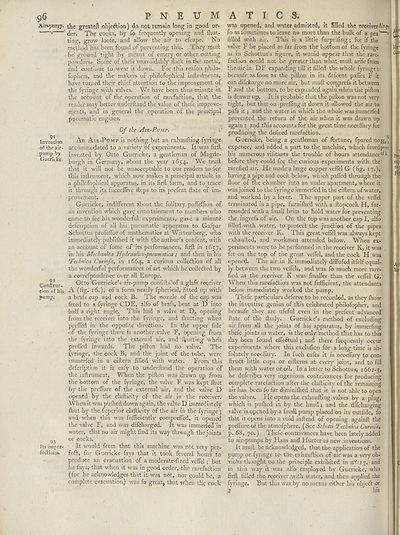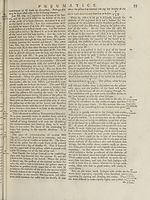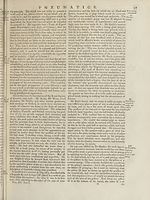Encyclopaedia Britannica > Volume 15, PLA-RAM
(112) Page 96
Download files
Complete book:
Individual page:
Thumbnail gallery: Grid view | List view

96
Airvpump.
91.
Invention
of the air-
pump by
Gueriike.
91
Conftruc-
tion < f his
pump.
Its imper*
fe^lionsk
P N E U M
the greateft objeftion) do not remain long in good or¬
der. The cocks, by fo frequently opening and (hut¬
ting, grow loofe, and allow the air to efcape. No
me\hod has been found of preventing this. They mull
be ground tight by means of emery or other cutting
powders^ Some of thefe unavoidably (lick in the metal,
and continue to wear it down. For this reafon phdo-
fopliers, and the makers of philofophical inftriiments,
have turned their chief attention to the improvement of
the fyringe with valves. We have been thus minute in
the account of the operation of rarefa&ion, that the
reader may better underhand the value of thefe improve¬
ments, and in general the operation of the principal
pneumatic engines.
Of the Air-Pump.
An Air-Pump is nothing but an exhaufting fyringe
accommodated to a variety of experiments. It was firft
invented by Otto Guericke, a gentleman of Magde-
burgh in Germany, about the year 1654. We truft
that it will not be unacceptable to our readers to fee
this inftrument, which now makes a principal article in
a philofophical apparatus, in its iiril form, and to trace
it through its fucceflive Heps to its prefent Hate of im¬
provement.
Guericke, indifferent about the folitary pofTeflion of
an invention which gave entertainment to numbers who
came to fee his wonderful experiments,- gave a minute
defcription of all his pneumatic apparatus to Gafpar
Schottus profcffor of mathematics at Wirtemberg, who
immediately publi(hed it with the author’s confent, with
an account of fome of its performances, firft in 1657,
in his Mechamca Hydraulico-pneumatica ; and then in his
Techn'ica Curiofny in 1664, a curious colle&ion of all
the wonderful performances of art which he colled!ed by
a eorrefpondence over all Europe.
Otto Guericke’s air-pump confifts of a glafs receiver
A (fig. 16.), of a form nearly fpherical, fitted up with
a brafs cap and cock B. The nozzle of the cap was
fixed to a fyringe CDE, alfo of brafs, bent at D into
half a right angle. This had a valve at D, opening
from the receiver into the fyringe, and fhutting when
preffed in the oppofite direction. In the upper fide
of the fyringe there is another valve F, opening from
the fyringe into the external air, and {putting when
prefled inwards. The pifton had no valve. The
fyringe, the cock B, and the joint of the tube, were
immerfed in a ciftern filled with water. From this
defcription it is eafy to underhand the operation of
the inftniment. When the pifton was drawn up from
the bottom of the fyringe, the valve F was kept fhut
by the preflure of the external air, and the valve D
opened by the elafticity of the air in the receiver.
When it was pufhed down again, the valve D immediately
(hut by the fuperior elafticity of the air in the fyringe;
and when this was fufficiently compreffed, it opened
the valve F, and was difcharged. It was immerfed in
water, that no air might find its way through the joints
or cocks.
It would feem that this machine was not very per-
feft, for Guericke fays that it took feveral hours to
produce an evacuation of a moderate-fized vefiel; but
he fays, that when it was in good order, the rarefaction
(for he acknowledges that it was not, nor could be, a
complete evacuation.) was fo great, that when the cock
A T I C S.
was opened, and water admitted, it filled the receiver Air.pu
fo as fometimes to leave n© more than the bulk of a pea
filled with air. This is a little furprifing; for if .the
valve F be placed as far from the bottom of the fyringe
as in Schottus’s figure, it would appear that the rare¬
faction could not be greater than what muft arife from
the air in DF expanding till it filled the whole fyringe:
becaufe as foon as the pifton in its defcent paffes F it
can difcharge no more air, but muft -comprefs it between
F and the bottom, to be expanded again when the pifton
is drawn up. It is probable that the pifton was not very
tight, but that on prefling it down it allowed the air to
pafs it; and the water in which the whole was immerfed
prevented the return of the air when it was drawn up
again : and this accounts for the great time neceflary for
producing the defired rarefaftion.
Guericke, being a gentleman of fortune, fpared noH^
expence, and added a part to the machine, which favedprovti
his numerous vifitants the trouble of hours attendance0^
before they could fee the curious experiments with the
rarefied air. He made a large copper veffel G (fig. 17.),
having a pipe and cock below, which palled through the
floor of the chamber into an under apartment, where it
was joined to the fyringe immerfed in the ciftern of water,
and worked by a lever. The upper part of the veffel
terminated in a pipe, furnifhed with a ftopcock H, fur-
rounded with a fmall brim to hold water for preventing
the ingrefs of air. On the top was another cap I, alfo
filled with water, to protec! the junction of the pipes
with the receiver K. This great veffel was always kept
exhaulled, and workmen attended below. When ex¬
periments were to be performed in the receiver K, it was
fet on the top of the great veffel, and the cock H was
opened. The air in K immediately diffufed itfelf equal¬
ly between the two veffels, and was fo much more rare¬
fied as the receiver K was fmaller than the veffel G.
When this rarefaftion was not fufficient, the attendants
below immediately worked the pump.
Thefe particulars deferve to be recorded, as they (how
the inventive genius of this celebrated philofopher, and
beeaufe they are ufeful even in the prefent advanced
ftate of the ftudy. Guericke’s method of excluding
air from all the joints of his apparatus, by immerfmg
thefe joints in water, is the only method that has to this
day been found effe&ual; and there frequently occur
experiments where this exclufion for a long time is ab-
folutely neceffary. In fuch cafes it is neceflary to con-
ftrud! little cups or oifterns at ever)’- joint, and to fill
them with water or oil. In a letter to Schottus, 1662-3,
he defcribea very ingenious contrivances for producing
complete rarefarfion after the elafticity of the remaining
air has been fo far diminiftied that it is not able to open
the valves. He opens the exhaufting valves by a plug,
which is puftied in by the hand; and the difcharging
valve is opened by a fmall pump placed on its outfide, fo
that it opens into a void inftead of opening againft the
preffure of the atmofphere. (See Schotti Technica Curio fa,
p. 68, 70.) Thefe contrivances have been lately added
to air-pumps by Haas and Hurter as new inventions.
It muft be acknowledged, that the application of the
pump or fyringe to the exhauftion of air was a very ob-
viofts thought on the principle exhibited in nw 17. and
in this way it was alfo employed by Guericke, who
firft filled the receiver with water, and then applied the
fyringe. But this was. by no means either his object or
2 his
Airvpump.
91.
Invention
of the air-
pump by
Gueriike.
91
Conftruc-
tion < f his
pump.
Its imper*
fe^lionsk
P N E U M
the greateft objeftion) do not remain long in good or¬
der. The cocks, by fo frequently opening and (hut¬
ting, grow loofe, and allow the air to efcape. No
me\hod has been found of preventing this. They mull
be ground tight by means of emery or other cutting
powders^ Some of thefe unavoidably (lick in the metal,
and continue to wear it down. For this reafon phdo-
fopliers, and the makers of philofophical inftriiments,
have turned their chief attention to the improvement of
the fyringe with valves. We have been thus minute in
the account of the operation of rarefa&ion, that the
reader may better underhand the value of thefe improve¬
ments, and in general the operation of the principal
pneumatic engines.
Of the Air-Pump.
An Air-Pump is nothing but an exhaufting fyringe
accommodated to a variety of experiments. It was firft
invented by Otto Guericke, a gentleman of Magde-
burgh in Germany, about the year 1654. We truft
that it will not be unacceptable to our readers to fee
this inftrument, which now makes a principal article in
a philofophical apparatus, in its iiril form, and to trace
it through its fucceflive Heps to its prefent Hate of im¬
provement.
Guericke, indifferent about the folitary pofTeflion of
an invention which gave entertainment to numbers who
came to fee his wonderful experiments,- gave a minute
defcription of all his pneumatic apparatus to Gafpar
Schottus profcffor of mathematics at Wirtemberg, who
immediately publi(hed it with the author’s confent, with
an account of fome of its performances, firft in 1657,
in his Mechamca Hydraulico-pneumatica ; and then in his
Techn'ica Curiofny in 1664, a curious colle&ion of all
the wonderful performances of art which he colled!ed by
a eorrefpondence over all Europe.
Otto Guericke’s air-pump confifts of a glafs receiver
A (fig. 16.), of a form nearly fpherical, fitted up with
a brafs cap and cock B. The nozzle of the cap was
fixed to a fyringe CDE, alfo of brafs, bent at D into
half a right angle. This had a valve at D, opening
from the receiver into the fyringe, and fhutting when
preffed in the oppofite direction. In the upper fide
of the fyringe there is another valve F, opening from
the fyringe into the external air, and {putting when
prefled inwards. The pifton had no valve. The
fyringe, the cock B, and the joint of the tube, were
immerfed in a ciftern filled with water. From this
defcription it is eafy to underhand the operation of
the inftniment. When the pifton was drawn up from
the bottom of the fyringe, the valve F was kept fhut
by the preflure of the external air, and the valve D
opened by the elafticity of the air in the receiver.
When it was pufhed down again, the valve D immediately
(hut by the fuperior elafticity of the air in the fyringe;
and when this was fufficiently compreffed, it opened
the valve F, and was difcharged. It was immerfed in
water, that no air might find its way through the joints
or cocks.
It would feem that this machine was not very per-
feft, for Guericke fays that it took feveral hours to
produce an evacuation of a moderate-fized vefiel; but
he fays, that when it was in good order, the rarefaction
(for he acknowledges that it was not, nor could be, a
complete evacuation.) was fo great, that when the cock
A T I C S.
was opened, and water admitted, it filled the receiver Air.pu
fo as fometimes to leave n© more than the bulk of a pea
filled with air. This is a little furprifing; for if .the
valve F be placed as far from the bottom of the fyringe
as in Schottus’s figure, it would appear that the rare¬
faction could not be greater than what muft arife from
the air in DF expanding till it filled the whole fyringe:
becaufe as foon as the pifton in its defcent paffes F it
can difcharge no more air, but muft -comprefs it between
F and the bottom, to be expanded again when the pifton
is drawn up. It is probable that the pifton was not very
tight, but that on prefling it down it allowed the air to
pafs it; and the water in which the whole was immerfed
prevented the return of the air when it was drawn up
again : and this accounts for the great time neceflary for
producing the defired rarefaftion.
Guericke, being a gentleman of fortune, fpared noH^
expence, and added a part to the machine, which favedprovti
his numerous vifitants the trouble of hours attendance0^
before they could fee the curious experiments with the
rarefied air. He made a large copper veffel G (fig. 17.),
having a pipe and cock below, which palled through the
floor of the chamber into an under apartment, where it
was joined to the fyringe immerfed in the ciftern of water,
and worked by a lever. The upper part of the veffel
terminated in a pipe, furnifhed with a ftopcock H, fur-
rounded with a fmall brim to hold water for preventing
the ingrefs of air. On the top was another cap I, alfo
filled with water, to protec! the junction of the pipes
with the receiver K. This great veffel was always kept
exhaulled, and workmen attended below. When ex¬
periments were to be performed in the receiver K, it was
fet on the top of the great veffel, and the cock H was
opened. The air in K immediately diffufed itfelf equal¬
ly between the two veffels, and was fo much more rare¬
fied as the receiver K was fmaller than the veffel G.
When this rarefaftion was not fufficient, the attendants
below immediately worked the pump.
Thefe particulars deferve to be recorded, as they (how
the inventive genius of this celebrated philofopher, and
beeaufe they are ufeful even in the prefent advanced
ftate of the ftudy. Guericke’s method of excluding
air from all the joints of his apparatus, by immerfmg
thefe joints in water, is the only method that has to this
day been found effe&ual; and there frequently occur
experiments where this exclufion for a long time is ab-
folutely neceffary. In fuch cafes it is neceflary to con-
ftrud! little cups or oifterns at ever)’- joint, and to fill
them with water or oil. In a letter to Schottus, 1662-3,
he defcribea very ingenious contrivances for producing
complete rarefarfion after the elafticity of the remaining
air has been fo far diminiftied that it is not able to open
the valves. He opens the exhaufting valves by a plug,
which is puftied in by the hand; and the difcharging
valve is opened by a fmall pump placed on its outfide, fo
that it opens into a void inftead of opening againft the
preffure of the atmofphere. (See Schotti Technica Curio fa,
p. 68, 70.) Thefe contrivances have been lately added
to air-pumps by Haas and Hurter as new inventions.
It muft be acknowledged, that the application of the
pump or fyringe to the exhauftion of air was a very ob-
viofts thought on the principle exhibited in nw 17. and
in this way it was alfo employed by Guericke, who
firft filled the receiver with water, and then applied the
fyringe. But this was. by no means either his object or
2 his
Set display mode to:
![]() Universal Viewer |
Universal Viewer | ![]() Mirador |
Large image | Transcription
Mirador |
Large image | Transcription
Images and transcriptions on this page, including medium image downloads, may be used under the Creative Commons Attribution 4.0 International Licence unless otherwise stated. ![]()
| Encyclopaedia Britannica > Encyclopaedia Britannica > Volume 15, PLA-RAM > (112) Page 96 |
|---|
| Permanent URL | https://digital.nls.uk/191902232 |
|---|
| Attribution and copyright: |
|
|---|
| Description | Ten editions of 'Encyclopaedia Britannica', issued from 1768-1903, in 231 volumes. Originally issued in 100 weekly parts (3 volumes) between 1768 and 1771 by publishers: Colin Macfarquhar and Andrew Bell (Edinburgh); editor: William Smellie: engraver: Andrew Bell. Expanded editions in the 19th century featured more volumes and contributions from leading experts in their fields. Managed and published in Edinburgh up to the 9th edition (25 volumes, from 1875-1889); the 10th edition (1902-1903) re-issued the 9th edition, with 11 supplementary volumes. |
|---|---|
| Additional NLS resources: |
|

